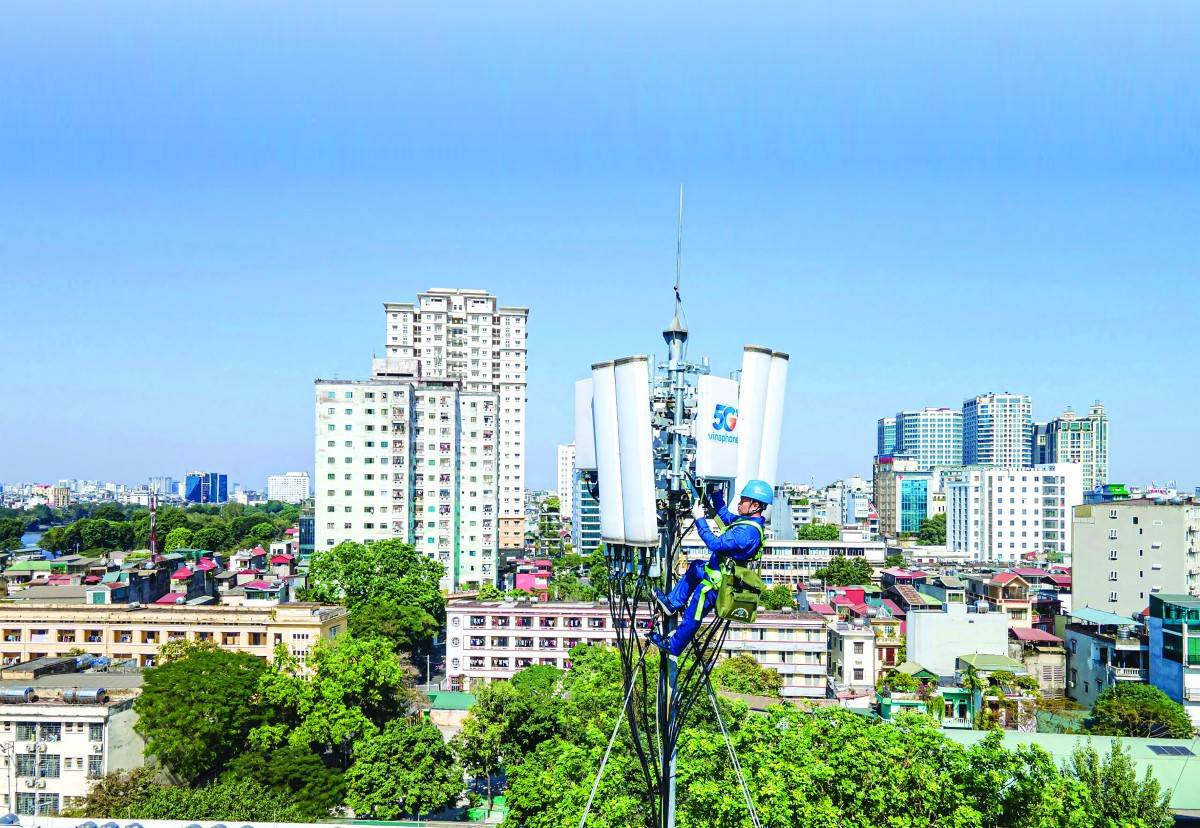Vietnam’s leading ICT enterprises, including Viettel, VNPT, MobiFone, FPT, CMC, and VNG, have significantly strengthened the country's telecommunications and information technology sector, positioning Vietnam as a global tech contender.
Viettel: Making telecommunications accessible for all
In the 1990s and early 2000s, Vietnam's telecommunications sector, despite its modern digital strategy, was perceived as expensive. Mobile phones cost around $1,000 each, with a network connection fee of $200 and a monthly subscription of $30. Local call charges in major cities were $0.30 per minute.
However, in 2000, Viettel entered the telecom market, revolutionizing the landscape. Starting with VoIP 178, Viettel reduced long-distance domestic and international call rates to 55-60% of traditional fees.
Viettel launched its mobile services in 2004, rapidly expanding and transforming mobile connectivity from a luxury to an everyday necessity. Mobile penetration skyrocketed from 5% in 2004 to over 100%, making Vietnam the fastest-growing mobile market globally.
Viettel’s success at home encouraged its international expansion. Since 2006, the company has established 10 telecom networks in 10 countries, serving nearly 100 million customers and holding the top market share in 6 countries.
By developing 4G and 5G technologies, Viettel placed Vietnam among the first five countries to successfully trial 5G in 2019 and became one of the top six telecom companies worldwide to produce 5G equipment.
As the only telecom operator globally to both operate and manufacture equipment, Viettel continues to lead with cloud computing and data storage solutions, aiming to ensure every citizen and enterprise in Vietnam can securely store and compute data on the cloud.
VNPT: Pioneering national digital transformation

Founded from the Post Office sector in 1975, VNPT (Vietnam Posts and Telecommunications Group) was once considered outdated. However, through innovation and transformation, VNPT became a modern industry leader.
By December 2003, VNPT had 7 million subscribers, achieving a density of 8 phones per 100 people two years ahead of the national goal. In April 2008, VNPT launched VINASAT-1, Vietnam’s first communications satellite, significantly enhancing national ICT infrastructure.
VNPT transitioned from a traditional telecom operator to a digital service provider in 2014, aspiring to become Vietnam’s top digital provider and a regional digital hub. The company also focuses on developing comprehensive digital ecosystems in education, healthcare, tourism, agriculture, and environmental management.
VNPT has been instrumental in building e-Government, digital government, smart cities, and digital economy solutions, collaborating closely with the government to implement large-scale national databases.
One notable project is the National Population Database, covering 11,000 communes and over 100 million citizens. VNPT’s contributions to this project earned recognition as a historic achievement by the Ministry of Public Security.
MobiFone: Vietnam’s first mobile network
Launched in 1993, MobiFone was the first mobile operator in Vietnam, adopting GSM technology from Europe. It partnered with Comvik/Kinnevik (Sweden) to leverage international expertise and capital.
Within its first year, MobiFone achieved a revenue of $2.2 million and pre-tax profit of $366,000, contributing $47,700 to the state budget — significant achievements given the economic challenges of the time.
Through consistent growth, MobiFone has maintained profitability and transformed from a pure telecom company into a digital service provider, aiming to be a core driver of national digital transformation and economic growth.
FPT: From humble beginnings to global IT powerhouse
Established in 1998, FPT became Vietnam’s top IT company by building ICT infrastructure for essential sectors. Despite early challenges in international expansion, FPT succeeded in Japan from 2005, opening offices in Singapore, Europe, and the US.
FPT’s global IT services revenue reached $1 billion in 2023, making it a prominent player among global IT service providers. The company is now focusing on five core areas: AI, Semiconductors, Automotive Technology, Digital Transformation, and Green Technology.
With its ambitious plan to reach $5 billion in revenue by 2030, FPT remains committed to leading Vietnam's digital future while pioneering advancements in artificial intelligence and technology exports.
CMC: From a computer company to a tech conglomerate
Founded in 1993, CMC started as a computer manufacturer and gradually expanded into software services, IT infrastructure, and telecommunications. The company’s CMC Global division, launched in 2017, focuses on software exports and IT services.
In 2024, CMC introduced the "Enable Your AI-X" strategy, aiming to revolutionize AI adoption in various sectors and strengthen Vietnam’s position in global IT. CMC continues to expand in Europe and the US, aiming to become a billion-dollar company with over 10,000 global employees by 2028.
VNG: From online games to a tech unicorn
Launched in 2004 as a game publisher, VNG rapidly diversified its portfolio, becoming Vietnam's first tech unicorn valued at $1 billion. Its business now spans online games, social platforms, payment services, and cloud solutions.
Zalo, VNG’s messaging app, has 75 million active users and is integral to Vietnamese daily life. VNG’s success in tech innovation has cemented its reputation as a pioneer in digital services.
From telecom breakthroughs to global IT exports and digital service leadership, Vietnam’s ICT enterprises have elevated the nation’s digital transformation. As Viettel, VNPT, MobiFone, FPT, CMC, and VNG continue to innovate, they not only empower the domestic economy but also position Vietnam as a global technology leader.
Ha Nguyen